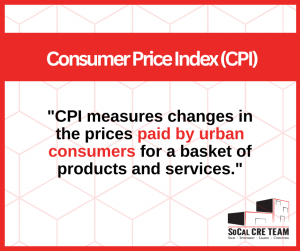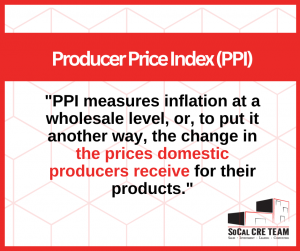With all the inflation talk going on these days, this is the ideal time to take a look at CPI and PPI, the two most common inflation indicators, and their impact on commercial real estate. Keep reading to learn more.
CPI vs. PPI: Which Metric Is More Important in Commercial Real Estate?
As you know, the term “inflation” refers to a rise in the general price consumers pay for goods and services. When it comes to the United States, the two most common ways to measure inflation are CPI and PPI.
Here, we discuss both CPI and PPI and their impact on Commercial Real Estate.
What Is CPI?
CPI stands for Consumer Price Index, a metric that measures changes in the prices paid by urban consumers for a basket of products and services.
As the most widely used inflation indicator, CPI affects almost everyone in the United States because it is used for things like:
- Adjusting consumers’ income payments (such as Social Security)
- Adjusting income eligibility levels for government assistance
- Serving as the base for cost-of-living wage adjustments to some American workers

You can check the latest CPI figures on the website of the U.S. Bureau of Labor Statistics.
What Is PPI?
The acronym PPI is short for Producer Price Index, a measurement of inflation at a wholesale level, or, to put it another way, the change in the prices domestic producers receive for their products.
Since PPI measures prices based on the first commercial transaction for a product or service, it is used for tracking price shifts by industry and for adjusting purchase and sales contracts.

Just like CPI, you can check PPI data by visiting the website of the U.S. Bureau of Labor Statistics.
CPI, PPI, and Commercial Real Estate
To sum it up: CPI looks at inflation from the point of view of consumers, while PPI measures wholesale inflation.
So, which inflation indicator is more important in Commercial Real Estate?
CPI is the measure most often used by landlords to adjust rent according to the fluctuating inflation levels, with the alternative being a fixed (or flat) percentage increase. This second option is less beneficial for the landlord when inflation levels exceed the agreed-upon percentage increase, as has often been the case over the last few months.
When crafting an CPI clause, it is necessary to pay attention to several factors, such as the selection of a specific CPI (CPI for All Urban Consumers is the most common choice) as well as minimum/maximum caps, among others.
If you need help figuring out CPI clauses, or are looking for assistance with any other aspect of Commercial Real Estate, get in touch with SoCal CRE team: we stand ready to answer all your questions.
Disclaimer: This material is for general information and educational purposes only. It is not guaranteed as to accuracy, does not purport to be complete and is not intended to be used as a primary basis for investment decisions.
SoCal CRE Team: The Experts in Commercial Real Estate in Southern California
At SoCal CRE Team, we specialize in industrial real estate solutions in the most sought-after Southern California markets such as Los Angeles, Orange County, Riverside, Anaheim, and more.
Interested in learning more? Contact us today by telephone (714) 456-0500 or email at gary@ashwillassociates.com.
For more information about essential CRE topics, check out our previous blogs, “What Is Floor Area Ratio?” and “Are CAM Charges Negotiable?”




